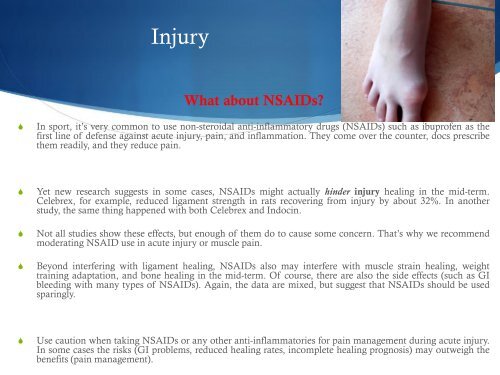Nutrition for Running
Create successful ePaper yourself
Turn your PDF publications into a flip-book with our unique Google optimized e-Paper software.
Injury<br />
What about NSAIDs?<br />
S<br />
In sport, it’s very common to use non-steroidal anti-inflammatory drugs (NSAIDs) such as ibuprofen as the<br />
first line of defense against acute injury, pain, and inflammation. They come over the counter, docs prescribe<br />
them readily, and they reduce pain.<br />
S<br />
S<br />
S<br />
Yet new research suggests in some cases, NSAIDs might actually hinder injury healing in the mid-term.<br />
Celebrex, <strong>for</strong> example, reduced ligament strength in rats recovering from injury by about 32%. In another<br />
study, the same thing happened with both Celebrex and Indocin.<br />
Not all studies show these effects, but enough of them do to cause some concern. That’s why we recommend<br />
moderating NSAID use in acute injury or muscle pain.<br />
Beyond interfering with ligament healing, NSAIDs also may interfere with muscle strain healing, weight<br />
training adaptation, and bone healing in the mid-term. Of course, there are also the side effects (such as GI<br />
bleeding with many types of NSAIDs). Again, the data are mixed, but suggest that NSAIDs should be used<br />
sparingly.<br />
S<br />
Use caution when taking NSAIDs or any other anti-inflammatories <strong>for</strong> pain management during acute injury.<br />
In some cases the risks (GI problems, reduced healing rates, incomplete healing prognosis) may outweigh the<br />
benefits (pain management).


